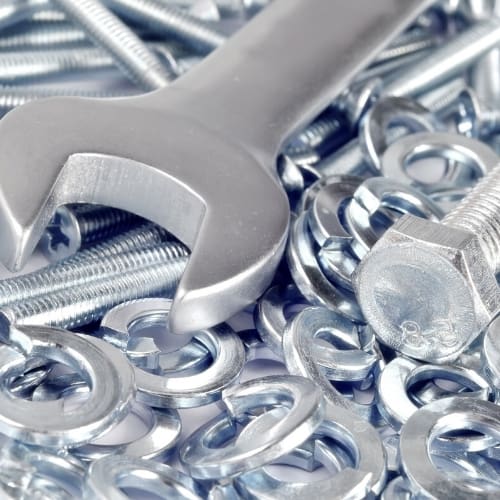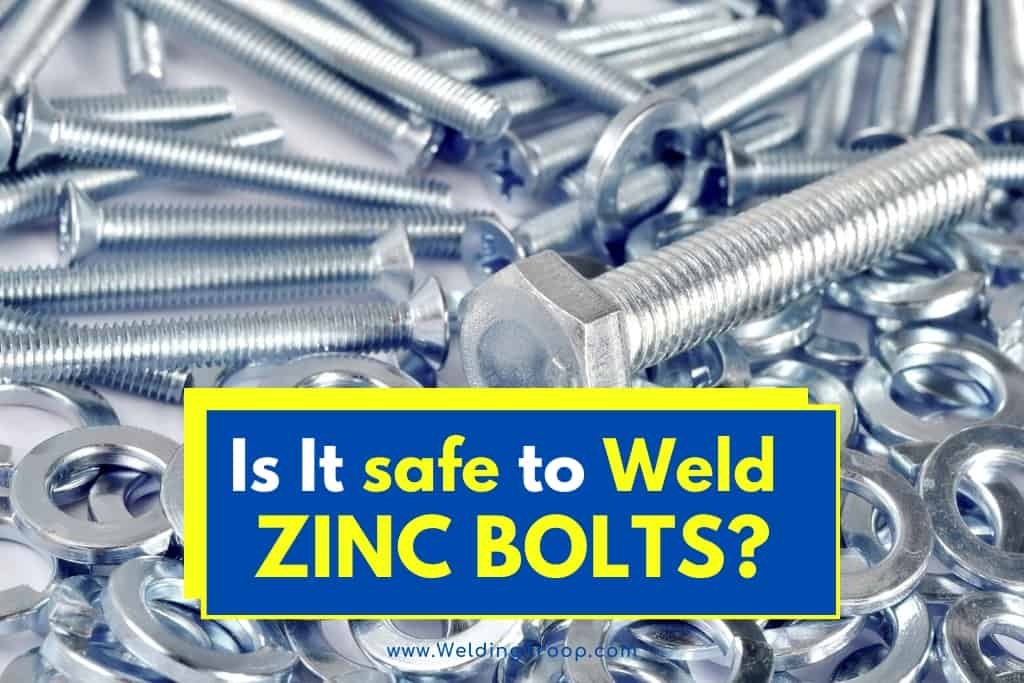Welding is an incredibly useful skill, with many applications and materials. However, not every material is as safe to weld as the next. It is essential to understand the risks and safety procedures involved with every metal, as some, like zinc, can be dangerous if precautions aren’t taken.
Can you weld zinc bolts? Yes, zinc bolts can be welded if you follow the proper safety guidelines. Bolts must be appropriately prepared, safety equipment must be worn, and adequate ventilation is essential.
We will explain more about the guidelines and preparation so you can safely weld zinc bolts.
Table of Contents
What makes zinc different from other bolts?
When we talk about zinc in items like bolts, we are generally talking about steel items coated in other metals to enhance the steel. This coating allows for steel to be used in applications where a higher resistance to rust is required. The coating uses two methods, zinc plating and hot-dip galvanizing, to coat the steel.
Also, zinc within a weld can cause some issues in your weld. If it is just small tack welding, you shouldn’t have any problems. But, when running a bead, zinc can cause porosity that can weaken the weld.

Zinc Plating
Zinc plating uses electroplating to coat the steel in a thin layer of zinc. The result is either a shiny silver or golden appearance that will resist corrosion well. However, if the zinc coating is damaged or items coated with zinc are used in a marine environment, they will rust.
Hot Dip Galvanizing
Galvanizing also adds a layer of zinc to bolts. However, as the name implies, the bolts are dipped into molten zinc to allow the thickest coat possible. This produces a dull grey color on the bolts that can now hold up very well to corrosive environments like coastal areas.
Another important note when identifying hot-dip galvanized bolts is their nuts. The galvanized nuts must be tapped to a slightly larger size to accommodate the thick coating. If you find that a bolt isn’t fitting with a nut of the proper size, it’s probably galvanized.
Zinc Poisoning
You might be wondering, why is all this important? Well, it is because of safety. When zinc is welded, it evaporates into the air and can cause zinc poisoning. Also known as “Metal Fume Fever,” zinc poisoning causes flu-like symptoms that can last a couple of days. However, the long-term effects are still being studied.
The levels in which zinc poisoning can occur are lower than the OSHA standards state. The symptoms can also come on within a matter of hours after exposure, so it is vital to take all precautions when welding zinc.
Related reading: Why Is Welding Galvanized Steel Dangerous?
How to Weld Zinc and Avoid the Dangers of Zinc Poisoning
It should be noted that some bolts’ grades and size make it impossible or unsafe to weld them. Be sure to understand the heating from welding will ruin the heat treating done to bolts and can make them unsafe. If you need to weld bolts and cannot avoid using zinc, there are some steps you can take to do it safely.
- Make sure your work is well ventilated if you are welding indoors. If you have a vent hood, it needs to be on. If you do not, make sure fans or blowers are running to push the air away. If neither is an option, do your welding outdoors.
- Wear a respirator that is rated for gasses. Dust masks or bandanas are not enough to keep you from breathing in the fumes, and a welding mask can trap the vapors inside of them. For more information on respirators and their uses, check here.
- Do not place your head directly over the welding area. The gasses will rise, so having your head off to the side will remove it from the path of the gasses.
- Burn away the zinc. If you have an oxyacetylene torch, you can burn away the zinc in the welding area. Keep in mind that this will not work for thinner metals. Higher heats may also remove the tempers from your project.
- Grind away the zinc coating. Using a grinding wheel or flap disk, you can remove the zinc layers in the welding area. You should remove the zinc 1 to 4 inches around the area that you will be welding. If you are welding thin materials like sheet metal or thin stock, you should remove the zinc on both sides of the material.
- Clean any [articles left behind by grinding to ensure there is no zinc dust in the welding area. Use acetone and allow it to dry before welding.
After finishing your welds and dressing them properly, they will have lost their zinc protection. You can reapply zinc to metal to protect it from corrosion. There are a few different ways this can be done.
Electroplating
For small pieces, you can have it electroplated or get a DIY electroplating system. This process uses electricity, electrolytes, and different metals to transfer one metal to the surface of another.
Cold Galvanizing
Cold galvanizing is essentially painting on a compound, so it is easy to do. This comes in aerosol and liquid for whatever may work on your project. Simply apply it to the cooled and cleaned metal and let it dry.
Dry Brushing
The dry brushing method uses a brush with the desired metal, in this case, zinc, to “brush on” to the steel. It works by friction, the steel pulling off, and holding onto the bits of zinc that come loose from the brush. This will apply the zinc and create a rough brushed look to the piece.
What Welding Works?
Various welding methods are used for different materials and purposes. Here is a list of the ways that work:
Gas Metal Arc Weld: Also known as Metal-Inert Gas welding, or MIG welding, can be used for thinner galvanized materials but must be done slowly.
Shielded Metal Arc Welding: Also known as stick welding, SMAW will weld galvanized steels with thicknesses greater than 1 inch, so they will not work with something as small as bolts. It will work with larger pieces of steel. If the welding speed is lowered and your angle is decreased, you will get a better weld.
Oxyacetylene Welding: Using an Oxyacetylene torch and filler rods to do fusion welding will work with galvanized steel. However, the zinc coating is affected in a much larger area because of the extra heat and lower heat control. The appearance of the welds is not attractive and should not be “cleaned up” by reheating the weld, as this will cause further issues with the zinc coating.
Keep in mind that torch welding is likely to remove the temper from any bolts, causing them to be weaker.
Suspected Zinc Poisoning
If you have been welding zinc or unknown metals in an unsafe environment, you may begin to feel unwell. In addition to flu-like symptoms, more severe symptoms can include:
- Body pain
- Trouble breathing
- Burning sensations
- Cough
- Watery or bloody stool
- Fever or chills
- Lowered blood pressure
- Metallic taste
- Yellowing of the eyes or skin
- Lack of urine
- Rash
- Shock
- Collapse
- Convulsions
- Vomiting
If you suspect you have zinc poisoning, you should seek medical help immediately. While it usually goes away on its own, more severe cases can cause other health complications.
Conclusion
You are now armed with the knowledge of how to weld zinc bolts. Knowing and understanding the materials you are working with is not only important to ensure that you do quality work, but it is essential to protect yourself from hazards. Working safely means that you will able to continue doing what you love.
Remove zinc plating from steel >> Check out the video below
Here are some of my favorite tools & equipment´s
Thank you for reading this article. I hope it helps you find the most recent and accurate information for your welding project. Here are some tools that I use daily and hope you´ll also find helpful.
There are affiliate links, so if you do decide to use any of them, I´ll earn a small commission. But in all honesty, these are the exact tools that I use and recommend to everyone, even my own family. (NO CRAP)
To see all my of most up-to-date recommendations, check out this resource that I made for you!
Recommended Reading
Respirators for Welding Galvanized Steel | Welding Hazards Respiratory Protection
Can You Weld Galvanized Steel? Step by Step Complete Guide
Is it Safe to Weld an Air Compressor Tank? | Air Tank Repair


